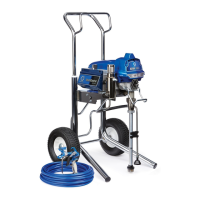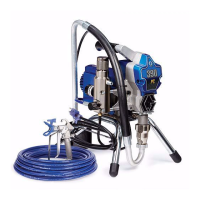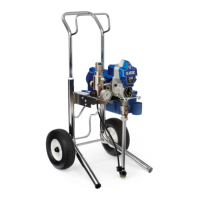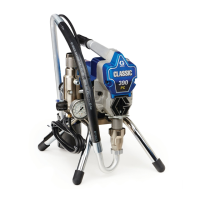308-088
Moving parts can pinch or amputate your fingers or other body
parts. KEEP CLEAR of moving parts when starting or operating
the sprayer. Follow the +!,,.+! !&%!" +)! .+! on page 2
before checking or servicing any part of the sprayer, to prevent
it from starting accidentally.
!(!+& "!-0
Any misuse of the spray equipment or accessories, such as
overpressurizing,modifyingparts,usingincompatiblechemicals
and fluids, or using worn or damaged parts, can cause them to
ruptureand result in fluid injection,splashing in theeyes or on the
skin, or other serious bodily injury, or fire, explosion or property
damage.
NEVER alter or modify any part of this equipment; doing so could
cause it to malfunction.
CHECK all spray equipment regularly and repair or replace worn
or damaged parts immediately.
Always wear protective eyewear, gloves, clothing and respirator
as recommended by the fluid and solvent manufacturer.
0,-!' +!,,.+!
This sprayer can develop 172 bar (2500 psi) MAXIMUM WORKĆ
ING PRESSURE. Be sure all spray equipment and accessories
used are rated to withstand this pressure. DO NOT exceed the
maximum working pressure of any component or accessory
used in the system.
&.% ( )&/!(- )'*-%%&%-0
All chemicals used in the sprayer must be chemically compatible
with the wetted parts shown in the on page
28. Consult your chemical supplier to ensure compatibility.
Donotuse1,1,1Ćtrichloroethane,methylenechloride,otherhaloĆ
genatedhydrocarbonsolventsorfluidscontainingsuchsolvents
in this equipment, which contains aluminum and/or zinc parts.
Suchusecouldresult inaseriouschemicalreaction,withtheposĆ
sibilityofexplosion,whichcouldcausedeath,seriousbodilyinjuĆ
ry and/or substantial property damage.
High pressure fluid in the hoses can be very dangerous. If the
hose develops a leak, split or rupture due to any kind of wear,
damage or misuse, the high pressure spray emitted from it can
causea fluid injection injuryor other serious bodily injury orpropĆ
erty damage.
Thestrainreliefshelpprotectthehosefromkinksorbends
at or close to the coupling which can result in hose rupture.
TIGHTEN all fluid connections securely before each use. High
pressure fluid can dislodge a loose coupling or allow high presĆ
sure spray to be emitted from the coupling.
NEVER use a damaged hose. Before each use, check the entire
hoseforcuts,leaks,abrasion,bulgingcover,ordamageormoveĆ
ment of the hose couplings. If any of these conditions exist, reĆ
place the hose immediately. DO NOT try to recouple high presĆ
sure hose or mend it with tape or any other device. A repaired
hose cannot contain the high pressure fluid.
HANDLE AND ROUTE HOSES CAREFULLY. Do not pull on
hosesto move equipment. Keep hosesclear of movingparts and
hot surfaces of the pump. Do not use fluids or solvents which are
notcompatiblewith theinnertubeand coverofthe hose.DONOT
exposeGraco hoses to temperaturesabove 82
C (180 F) orbeĆ
low -40
C (-40 F).
),! +).( %(# )(-%(.%-0
Proper hose grounding continuity is essential to maintaining a
grounded spray system. Check the electrical resistance of your
fluid hoses at least once a week. If your hose does not have a tag
on it which specifies the maximum electrical resistance, contact
the hose supplier or manufacturer for the maximum resistance
limits. Use a resistance meter in the appropriate range for your
hose to check the resistance. If the resistance exceeds the recĆ
ommended limits, replace it immediately. An ungrounded or
poorly grounded hose can make your system hazardous. Also
read below
Static electricity is created by the flow of fluid through the pump
and hose. If every part of the spray equipment is not properly
grounded,sparkingmayoccur,andthesystemmaybecomehazĆ
ardous.Sparkingmayalsooccurwhenplugginginorunplugging
apowersupplycordorusingagasolineengine.Sparkscanignite
fumes from solvents and the fluid being sprayed, dust particles
and other flammable substances, whether you are spraying inĆ
doors or outdoors, and can cause a fire or explosion and serious
bodily injury and property damage. Always plug the sprayer into
an outlet located at least 6 m (20 feet) away from the sprayer and
the spray area. Do not plug in or unplug any power supply cords
in the spray area when there is any chance of igniting fumes still
in the air.
If you experience any static sparking or even a slight shock while
using this equipment, . Check
the entire system for proper grounding. Do not use the system
again until the problem has been identified and corrected.
+).( %(#
To reduce the risk of static sparking, ground the sprayer and all
other spray equipment used or locatedin the spray area. CHECK
your local electrical code for detailed grounding instructions for
your area and type of equipment. BE SURE to ground all of this
spray equipment:
1. Sprayer: plug the power supply cord, or extension cord -
each equipped with an undamaged, grounded plug, into a
properlygrounded outlet.Do notuse an adapter.All extension
cords must have three wires and be rated for 15 Amps.
2. Fluid hoses: use only grounded hoses with a maximum
f
150 m (500 feet) combined hose length to ensure grounding
continuity. See ),! +).( %(# )(-%(.%-0 above.
3. Spraygun: obtain groundingthroughconnectiontoa properly
grounded fluid hose and sprayer.
4. Object being sprayed: according to local code.
5. Fluid supply container: according to local code.
6. All solvent pails used when flushing, according to local code.
Use only metal pails, which are conductive. Do not place the
pail on a non-conductive surface, such as paper or cardĆ
board, which interrupts the grounding continuity.
7. To maintain grounding continuity when flushing or relieving
pressure, always hold a metal part of the gun firmly to the side
of a grounded metal pail, then trigger the gun.
&.,$%(# "!-0
Reduce the risk of fluid injection injury, static sparking, or splashĆ
ing by following the flushing procedure given on page 9 of this
manual.Followthe onpage
2, and remove the spray tip before flushing. Hold a metal part of
the gun firmly to the side of a grounded metal pail and use the
lowest possible fluid pressure during flushing.
United States Government safety standards have been adopted under the Occupational Safety and Health Act. These standards -
particularly the General Standards, Part 1910, and the Construction Standards, Part 1926 - should be consulted.
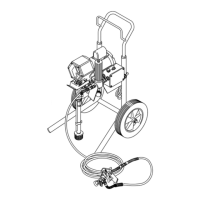
